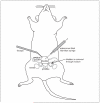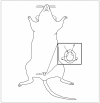Mouse models of human bladder cancer as a tool for drug discovery
- PMID: 22294368
- PMCID: PMC3272628
- DOI: 10.1002/0471141755.ph1414s49
Mouse models of human bladder cancer as a tool for drug discovery
Abstract
Muscle-invasive bladder cancer is a deadly condition in dire need of effective new treatments. This unit contains a description of mouse models suitable for the evaluation of potential new therapies. Included is a genetically engineered mouse model of bladder cancer generated by the delivery of an adenovirus expressing Cre recombinase into the bladder lumen. Also described is an orthotopic mouse model created by the instillation of human bladder tumor cells into the bladder lumen of immune deficient mice. Protocols are also provided on the use of these models for the preclinical evaluation of new chemical entities, with mTOR inhibitors shown as an example.
Figures




Similar articles
-
Establishment of orthotopic mouse superficial bladder tumor model for studies on intravesical treatments.Hum Cell. 2008 Aug;21(3):57-63. doi: 10.1111/j.1749-0774.2008.00055.x. Hum Cell. 2008. PMID: 18667021
-
Evaluation of Su Fu'ning Lotion's Inhibitory Effects on Bladder Cancer Cells In Vitro and In Vivo by Intravesical Instillation.Integr Cancer Ther. 2016 Mar;15(1):80-6. doi: 10.1177/1534735415596569. Epub 2015 Aug 27. Integr Cancer Ther. 2016. PMID: 26315609 Free PMC article.
-
[Double-mutated oncolytic adenovirus combined with gemcitabine for treating an orthotopic nude mouse model of bladder cancer].Zhonghua Zhong Liu Za Zhi. 2013 Jun;35(6):412-7. Zhonghua Zhong Liu Za Zhi. 2013. PMID: 24119899 Chinese.
-
Animal models of urinary bladder cancer and their application to novel drug discovery.Expert Opin Drug Discov. 2014 May;9(5):485-503. doi: 10.1517/17460441.2014.902930. Epub 2014 Mar 26. Expert Opin Drug Discov. 2014. PMID: 24670247 Review.
-
Use of preclinical models to assess the therapeutic potential of new drug candidates for bladder cancer.Semin Oncol. 2012 Oct;39(5):534-42. doi: 10.1053/j.seminoncol.2012.08.006. Semin Oncol. 2012. PMID: 23040250 Review.
Cited by
-
Modelling bladder cancer in mice: opportunities and challenges.Nat Rev Cancer. 2015 Jan;15(1):42-54. doi: 10.1038/nrc3858. Nat Rev Cancer. 2015. PMID: 25533675 Free PMC article. Review.
-
Tsc1-Tp53 loss induces mesothelioma in mice, and evidence for this mechanism in human mesothelioma.Oncogene. 2014 Jun 12;33(24):3151-60. doi: 10.1038/onc.2013.280. Epub 2013 Jul 15. Oncogene. 2014. PMID: 23851502 Free PMC article.
-
Systematic Review: Characteristics and Preclinical Uses of Bladder Cancer Cell Lines.Bladder Cancer. 2018 Apr 26;4(2):169-183. doi: 10.3233/BLC-180167. Bladder Cancer. 2018. PMID: 29732388 Free PMC article.
-
ATDC/TRIM29 Drives Invasive Bladder Cancer Formation through miRNA-Mediated and Epigenetic Mechanisms.Cancer Res. 2015 Dec 1;75(23):5155-66. doi: 10.1158/0008-5472.CAN-15-0603. Epub 2015 Oct 15. Cancer Res. 2015. PMID: 26471361 Free PMC article.
-
Preclinical Models for Bladder Cancer Research.Hematol Oncol Clin North Am. 2021 Jun;35(3):613-632. doi: 10.1016/j.hoc.2021.02.007. Epub 2021 Apr 16. Hematol Oncol Clin North Am. 2021. PMID: 33958154 Free PMC article. Review.
References
-
- Ahlering TE, Dubeau L, Jones PA. A new in vivo model to study invasion and metastasis of human bladder carcinoma. Cancer Res. 1987;15:6660–6665. - PubMed
-
- Branda CS, Dymecki SM. Talking about a revolution: The impact of site-specific recombinases on genetic analyses in mice. Dev. Cell. 2004;6:7–28. - PubMed
-
- Chin J, Kadhim S, Garcia B, Kim YS, Karlik S. Magnetic resonance imaging for detecting and treatment monitoring of orthotopic murine bladder tumor implants. J. Urol. 1991;145:1297–1301. - PubMed
-
- Chong L, Ruping Y, Jiancheng B, Guohong Y, Yougang F, Jiansong W, Xiang G, Jie H, Shusheng X. Characterization of a novel transplantable orthotopic murine xenograft model of a human bladder transitional cell tumor (BIU-87) Cancer Biol. Ther. 2006;4:394–398. - PubMed
-
- Cordon-Cardo C. Molecular alterations associated with bladder cancer initiation and progression. Scand. J. Urol. Nephrol. Suppl. 2008;42:154–165. - PubMed
Publication types
MeSH terms
Substances
Grants and funding
LinkOut - more resources
Full Text Sources
Medical
Miscellaneous

